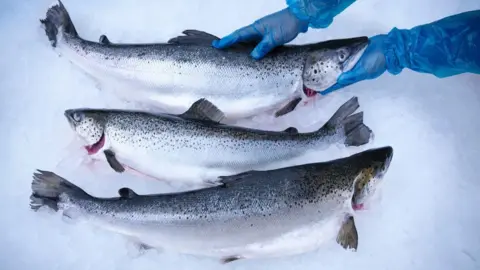Business and economy editor, Scotland
 Getty Images
Getty Images“Shortbread is America’s second favourite cookie, after chocolate chip,” says Anne Robinson, owner of Scottish Gourmet USA, a small business in North Carolina. She imports Scottish produce and sells it at her store in Greensboro and online.
“But how much will consumers pay for their little pleasures?”
Along with Andrew Hamilton, her Scottish husband, she’s about to find out. They are putting up prices, partly due to the 10% tariff on imports into the US from Scotland.
There are other reasons, including the weakened US dollar against the British pound, higher healthcare costs for her employees and higher employer costs for her suppliers of “bangers, bacon, pies, tablet, kippers, bannocks, cheese, shortbread, fudge, mugs and more”.
“We sell the luxury brands of shortbread, along with Walker’s, the world’s biggest maker of shortbread,” Anne says.
“All the prices are higher today than a year ago because butter costs have skyrocketed. Now add the tariff and every box of cookies has gone up by at least $1.
“At some point, consumers will not buy a box of Scottish shortbread at $10 when American-made Lorna Doone shortbread sells for $5-6.”
 Scottish Gourmet USA
Scottish Gourmet USAThat may make Donald Trump’s point for him. He wants to use tariffs to discourage Americans from importing, replacing those choices with American ones.
That could put jobs at risk in Aberlour on Speyside, for instance, where Walker’s makes shortbread in vast quantities, much of it for export, employing up to 1,700 people in peak pre-Christmas season.
It could boost jobs in the US bakeries where Lorna Doone Shortbread cookies are made by snacks goliath Mondelez.
These are the more straightforward effects of tariffs – the taxes paid by importers as goods arrive in the country imposing the charge, usually as a percentage of its value.
But with such uncertainty around tariffs because of Donald Trump’s capricious policy-making, we’ve only recently begun to get an idea of the effects.
Bigger companies are beginning to put a price on US tariffs, led by car makers. Toyota says it looks like a full-year hit of £7.1bn. Honda, also facing 15% tariffs on Japanese-made cars being sold into the US, says the cost will be more than £2.3bn.
US auto-makers are hard hit too, because they are international businesses and many of their vehicles have parts manufactured across national boundaries, including those with Canada and Mexico.
General Motors expects the rise in tariffs to cost it between £3bn and £4bn annually. Ford forecasts tariffs will cost it £1.5bn this year. Caterpillar, maker of construction machinery, has an estimate of £1.bn.
Americans are beginning to assess the impact on the goods they buy. Importers have absorbed most of the costs until now.
Economists have been surprised that they have not been passing costs on in prices, and pushing up inflation, but they continue to expect that will come.
One early sign is that wholesale prices took a big jump last month – up by 0.9% when the expectation was of only 0.2%. The next signs could come from the big retail chains led by Walmart, reporting to the markets this week.
Coffee from Brazil will carry a 50% tariff. Cars from Germany, as with other EU exports of food and machinery, face a 15% charge at the point of import. Watches, cheese and gold from Switzerland will carry a 39% tariff.
Many US smartphones are made in India, which is seeing a 25% tariff imposed on exports to the USA, and that could be doubled within three months as punishment for India buying Russian oil.
Such high rates could be negotiated down, if Brazil’s or India’s leaders are willing to plead. Neither sounds like they are. Along with South Africa, there could be a new alliance of large economies which are unwilling to accept US tariffs without retaliation.
President Trump is yet to meet with China’s leadership to discuss tariffs.
His summit with Russia’s President Putin in Alaska on Friday left yet more uncertainty.
Having gone into the meeting threatening tougher measures against Russia, to punish it for aggression in Ukraine, as well as further tariffs on those, such as India, who buy goods from Russia, the US president has not commented on either.
The UK came off relatively lightly from the trade deals struck so far, with the 10% baseline tariff applied across the board, but uncertainty about steel and pharmaceuticals remains.
A bottle of Scotch whisky will carry that 10% tariff. Diageo, owner of Johnnie Walker and several well-known single malts while also a distiller of spirits within the US, estimates the annual cost at £150m.
‘We should be thriving, instead we’re struggling’
The risk for Americans is, first, that imported goods will go up in price and, second, that components for US manufacturers will become more expensive, pushing up prices of goods completed in the US.
The third effect is expected to be that such trade barriers act as an invitation to US producers to put up prices simply because they can. They are protected from overseas competition.
A fourth impact could be that when Americans travel overseas, as both president and vice-president have been in doing in Scotland, the weakened dollar makes that so-called “invisible export” more expensive for them – by around 10% in the case of the UK than it was last year.
Where Americans are employed in selling imported goods, their businesses and jobs are on the line.
Anne Robinson at Scottish Gourmet USA says: “Tariffs are a tax that benefits no-one. There is no service, no government program, nothing except this added cost.
“These are taxes on US companies that import anything – hurting small business and large, making planning and pricing nearly impossible as the possible tariffs change frequently.”
She lists the various opportunities being lost because of the Trump policy: “We are holding off hiring, raising wages for deserving employees, possible expansion of our warehouse space and many other possible purchases that could help our business grow because of the tariffs and resulting fall in the value of the dollar.
“When we should be thriving, instead we are struggling.”
One response for US trading partners is to look elsewhere. The UK has reason to get closer again to the European Union. After years of delays and obstacles in talks between the EU and India, the Trump effect seemed to spark momentum into its talks with post-Brexit Britain.
Canada faces the biggest hit from tariffs, as its economy has become so integrated, so it is looking to a future with a lot less US in it.
But there’s another economic effect from countries which have lost markets in the world’s biggest economy, leaving them with surplus product and capacity.
The secondary effect will be felt as goods are re-directed into alternative markets.
With steel already established as the Chinese export that was top of the list of US targets for tariffs, other countries, including the UK, have taken steps to stop China dumping its excess steel in other markets at prices that undercut domestic production.
With steel already established as the Chinese export that was top of the list of US targets for tariffs, other countries including the UK have taken steps to stop China dumping its excess steel in other markets at prices that undercut domestic production.
Not many of us buy steel directly, so we will not feel the impact directly. We do buy salmon, however, and that is already seeing the effects of markets being distorted and trade redirected.
Scotland has a premium product that sells into the US market. The trade figures for the first half of 2025, released on Thursday, showed exports to the US more than doubled since last year.
At £190m exports in six months, that puts US imports close to those of France, the biggest importer of Scottish salmon. However, that may be a temporary distortion of trade patterns, front-loading imports for freezing ahead of tariffs being introduced.
Having a much longer shelf-life, Scotch whisky exporters have shifted stock into the US since Donald Trump’s election victory last November.
The trade figures released on Thursday showed a big surge across categories of goods in the first quarter of the year, and then a big slump since April.
Scottish salmon exporters face that 10% US tariff, while Norway faces one at 15%. So Scottish salmon gets an advantage over Norwegian, a differential that will also distort other markets.
The US produces its own salmon, but not much of the Atlantic species. Half of its consumption of that has come from Chile.
Assuming a 10% tariff on this, the trade body for the Chilean aquaculture industry forecasts a trade loss of more than £1bn.
What does this mean for Scotland?
According to a well-placed source in the Scottish salmon industry, Chile, Canada and Norway are looking to “redirect more product into lower-tariff export markets like the EU to maintain sales”.
“This shift is already having an impact,” they say. “Market studies have highlighted how other producing countries are treating Europe and parts of Asia as a ‘safe haven’ for diverted supply, which is adding to volumes in the European market.”
An industry analyst at Norwegian seafood data firm Kontali, Philip Scrase, recently published a note about salmon prospects, with production set to rise.
In the US, he observed the effect of tariffs could be complex.
He said: “The move may hurt US seafood processors and consumers more than it helps domestic producers, particularly in the retail sector, where price sensitivity is high, and substitutes are limited.”
Salmon producers’ loss of US markets could be the European consumers’ gain, Mr Scrase says, as an increased supply from Chile pushes down prices.
Recent reporting from the seafood trade media pointed to sharply reduced prices for salmon from the dominant producer, Norway, at the same time as the sector expected a big 2025 harvest due to improved fish survival rates.
One consequence is a rush to freeze as much salmon as possible. Another is that some are reported as having to sell at less than it cost to produce.
That is explicitly why Salmon Scotland, the trade body, is stepping up its efforts to promote the third of Scottish salmon exports to France that qualify for the prestigious Label Rouge, a French marketing kitemark to signify food quality.
The Scottish government is matching Salmon Scotland’s £50,000 budget for the project.
So the consequences of this tariff war are being felt far from trade with the US, and will take time to feed through to new price levels elsewhere.
Back in North Carolina and Scottish Gourmet USA, Anne Robinson remains hopeful.
“My fingers are crossed in the hopes that our loyal customers will continue to buy their favourite cookies, candy, jam or haggis,” she says.




